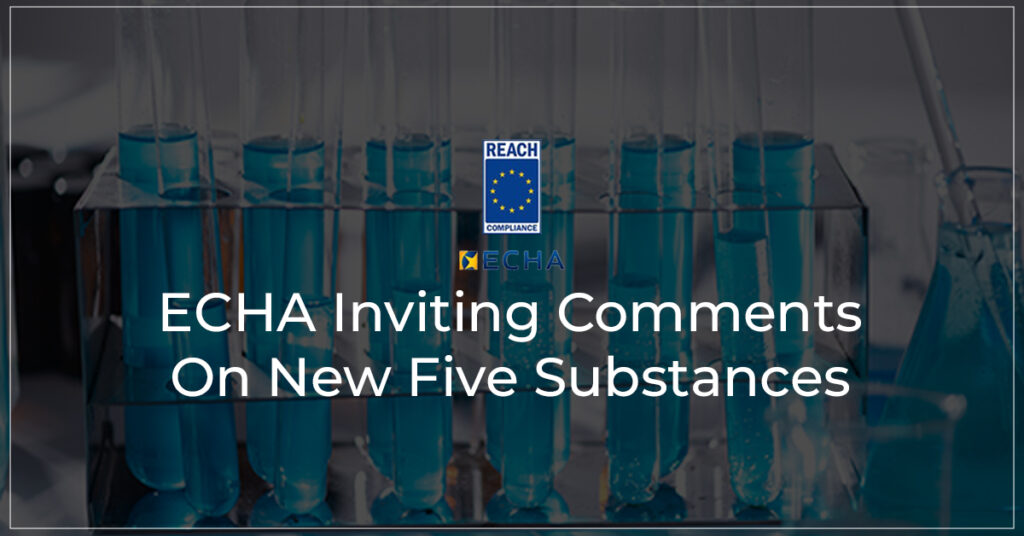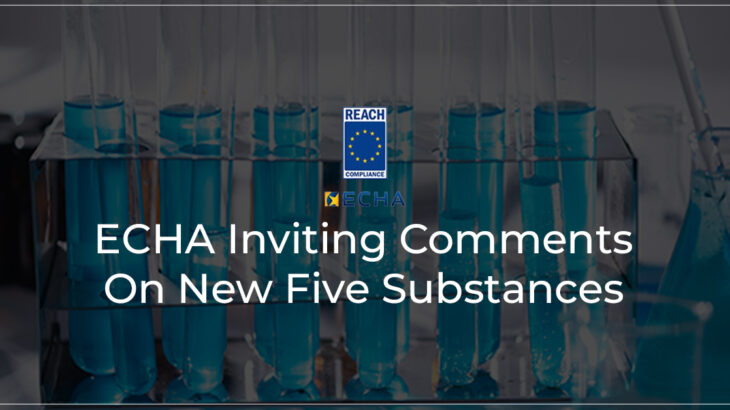
The European Chemicals Agency (ECHA) plays an integral role in assessing the chemical substance characteristics whether it can be placed in the European market within the European Union (EU). So, as part of the ECHA’s critical administration the Registration, Evaluation, Authorization, and Restriction of Chemicals or REACH compliance where the mechanism is designed to identify the Substances Of Very High Concern (SVHCs) and assess the risk associated with their usage.
Also, this compliance provides control over the adequate usage of SVHC substances and there are no alternatives available for the same. Hence, as a result ECHA consistently suggests substances listed in the Candidate List for inclusion in the Authorization List by the Commission. Should a substance be added to the Authorization List, it is prohibited from being marketed or utilized beyond a specified date unless authorization is provided for a particular purpose.
However, now ECHA has recommended five more substances on the Candidate List to be added on the Authorization List for their increased potential risk. Therefore, this blog explains the potential risks of SVHC substances and why they should be added to the Authorization List.
Considerations From ECHA For Chemical Substances
ECHA’s recent consultation recommends authorization for five substances identified as SVHCs. The consultation or inviting comments for adding the substances into the Authorization List is a crucial process. This may include the stakeholders, large-scale entities, industries, environmental organizations, and even the general public to share their insights or ideas over the suggested substances.
The five substances under consideration are,
Melamine:
The acknowledgement of melamine as a substance of significant concern is currently being disputed in front of the General Court of Justice. However, ongoing proceedings before the Court are not considered valid reasons for postponing or delaying ECHA’s recommendation. The outcome of the cases will be evaluated once they are finalized.
Bis(2-ethylhexyl) Tetrabromophthalate (TBPH):
The European Commission (EC) is inviting comments for the Bis(2-ethylhexyl) Tetrabromophthalate (TBPH), a primary component in the flame retardants. The primary aim is to help the commission to suggest to the ECHA whether to create a dossier of restriction for the substance. However, as there is no initiation over TBPH by the REACH restriction process or potential uses of the substances within the scope, the substance will remain in the draft for their inclusion in the Authorization List. Also, 5th April is considered as the deadline for the addition of TBPH in the Authorization List and the interested parties can submit evidence through a call.
S-(Tricyclo[5.2.1.0 2,6]Deca-3- En-8(Or 9)-Yl) O-(Isopropyl Or Isobutyl Or 2-Ethylhexyl) O- (Isopropyl Or Isobutyl Or 2- Ethylhexyl) Phosphorodithioate:
The substance S-(tricyclo[5.2.1.0 2,6]deca-3-en-8(or 9)-yl) O-(isopropyl or isobutyl or 2-ethylhexyl) O- (isopropyl or isobutyl or 2-ethylhexyl) phosphorothioate possesses an intrinsic property that qualifies it as a Substance of Very High Concern (SVHC) under Article 57d of REACH. This classification is due to its persistence, bioaccumulation, and toxicity (PBT) characteristics. The volume range for this substance within the scope of authorization is between 100 and less than 1,000 tons annually. It finds application primarily in lubricants and greases, notably in vehicles and machinery. Given its hazardous properties and significant usage volume, scrutiny and potential authorization under REACH are warranted to ensure proper risk management and control measures are in place.
Diphenyl(2,4,6- Trimethylbenzoyl)Phosphine Oxide:
Diphenyl(2,4,6-trimethylbenzoyl)phosphine oxide is classified as a Substance of Very High Concern (SVHC) under REACH due to its toxic effects on reproduction, as outlined in Article 57(c). The volume of its production or importation within the authorization scope falls between 1,000 to less than 10,000 tons per year. This compound is a photoinitiator commonly utilized in UV-curable inks, coatings, and adhesives. Given its intrinsic hazardous property and significant usage in various industrial applications, careful management and control are essential to mitigate risks to human health and the environment. Regulatory measures may be necessary to ensure its safe handling and explore feasible alternative substances.
Barium Diboron Tetraoxide:
Barium diboron tetraoxide, identified as a Substance of Very High Concern (SVHC) due to its toxic effects on reproduction (under Article 57c), falls within the scope of authorization for volumes ranging from 100 to less than 1,000 tons per year. This compound finds application in various industrial sectors, particularly in coatings and paints, thinners, and paint removers. Given its hazardous nature, regulatory authorities are keen to assess and manage its risks effectively. Authorization under REACH would entail thoroughly evaluating its uses, potential alternatives, and risk management measures. Stakeholders, including manufacturers, users, and environmental advocates, play a crucial role in providing information and insights to facilitate informed decision-making regarding the authorization of Barium diboron tetraoxide.
The Future Step
ECHA consistently suggests substances listed in the Candidate List for potential inclusion in the Commission’s Authorization List. These five extremely concerning substances from the Candidate List have been given priority based on the Member States Committee consideration. The preliminary recommendation is formulated after evaluating registration data and other accessible information, along with an initial consultation with the Member State Committee.
Considering the input gathered during this consultation, the Member State Committee will formulate an opinion on ECHA’s preliminary recommendation. Following the Committee’s opinion and the feedback obtained during the consultation process, ECHA will transmit its final recommendation to the European Commission in the spring of 2025. It marks ECHA’s twelfth recommendation. The Commission will determine the substances to include in the Authorization List and establish specific conditions for each.
ECHA seeks additional details regarding utilizing these substances within the scope of authorization, potential exemptions from authorization obligations, and the intricacies of supply chain structures. Hence, REACH registrants are urged to revise their usage data while submitting feedback.
ECHA’s consultation on recommending authorization for five substances under REACH highlights the ongoing efforts to manage and control the risks posed by hazardous chemicals within the EU. By engaging stakeholders in a transparent and inclusive decision-making process, ECHA aims to balance the need for robust risk management with promoting innovation and sustainability. The outcome of this consultation will shape the regulatory landscape for these substances, influencing industry practices, environmental protection measures, and public health outcomes for years to come. As a leading partner in Supply Chain Data Management we provide feedback to stay compliant with REACH, conflict mineral compliance, and SDS to safeguard human health and the environment while fostering a sustainable industry.




 +1.585.935.7123
+1.585.935.7123 +91-804-148-6861
+91-804-148-6861